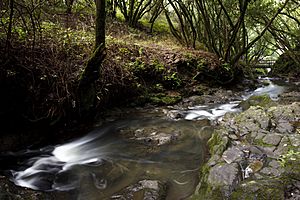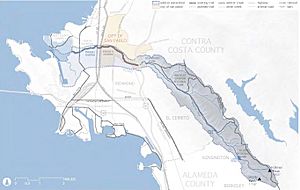Wildcat Creek (California) facts for kids
Quick facts for kids Wildcat Creek |
|
|---|---|

Wildcat Creek in 2011
|
|

Map of the Wildcat Creek watershed
|
|
| Other name(s) | Arroyo Seco, Arroyo Chiquito |
| Country | United States |
| State | California |
| Region | Contra Costa County |
| Cities | San Pablo, Richmond |
| Physical characteristics | |
| Main source | Vollmer Peak, Berkeley Hills Tilden Regional Park 1,515 ft (462 m) 37°52′55″N 122°13′34″W / 37.88194°N 122.22611°W |
| River mouth | Castro Creek Richmond, California 16 ft (4.9 m) 37°57′12″N 122°23′19″W / 37.95333°N 122.38861°W |
| Length | 12.5 mi (20.1 km) |
| Basin features | |
| Tributaries |
|
Wildcat Creek is a stream about 13.4 miles (21.6 km) long. It flows through a beautiful area called Wildcat Canyon. This canyon is nestled between the Berkeley Hills and the San Pablo Ridge. The creek eventually empties into San Pablo Bay in Contra Costa County, California.
Contents
History of Wildcat Creek
Early Explorers and Names
In 1772, the first Spanish explorers came across Wildcat Creek. They might have been in this area even earlier, in 1769. The expeditions led by Pedro Fages in 1772 and Juan Bautista de Anza in 1776 were warmly welcomed. They met people living in two villages along Wildcat Creek. One village was thought to have 100 to 200 people.
Sadly, within 30 years, almost all the native Huchiun people were forced to move. They had to go to Mission Dolores and become Christians.
On an old map from 1830, Wildcat Creek was called Arroyo Seco. This means "Dry Creek" in Spanish. Later, it was also known as Arroyo Chiquito, which means "Tiny Creek".
An 1861 map shows Wildcat Creek was once called Little San Pablo Creek. The "Big" San Pablo Creek is located just east of Wildcat Creek. There are over 50 places in California named "wildcat". This name either refers to the bobcats that used to live there, or to the idea of an "unsound scheme."
Wildcat Creek Watershed
The Wildcat Creek watershed is the area of land that drains into the creek. It covers about 11.1 square miles (28.7 km²). The creek starts high up on Vollmer Peak in Tilden Regional Park. This park is just east of the city of Berkeley.
As it flows, Wildcat Creek helps fill two artificial lakes. These are Lake Anza, built in 1938, and the smaller Jewel Lake, built in 1921. Further down, the creek flows through the city of San Pablo. It also passes through parts of Richmond.
Where the creek leaves the hills, it goes through Alvarado Park. This park has a stone arch bridge built over the creek by the WPA. The creek also flows through San Pablo's civic center and Davis Park. Wildcat Creek ends in the 387-acre (157 ha) Wildcat Marsh. From there, it flows into San Pablo Bay.
Wildcat Creek Ecology and Wildlife
The Wildcat San Pablo Creeks Watershed Council is a group that works to protect the creek. They won an environmental award in 2003. This group started in 1985 and is the oldest urban watershed council in California.
In 2004, the council began a plan called the Wildcat Creek Watershed Restoration Plan (WRAP). This plan aimed to fix problems with flooding in San Pablo. It also focused on improving the creek's natural environment. The plan was published in April 2010.
The WRAP had three main goals:
- Reduce flood risk from Wildcat Creek's big floods.
- Improve the natural areas along the creek. This helps fish like coastal rainbow trout (Oncorhynchus mykiss irideus). It also helps bring back anadromous steelhead trout. These fish travel from the ocean to spawn in fresh water.
- Create new places for the community to enjoy. This includes a 2-mile (3.2 km) Wildcat Creek Trail through the city.
In September 2010, the City of San Pablo received a $1.8 million grant. This money from the state Department of Water Resources was for cleaning up Wildcat Creek.
Steelhead Trout Restoration
Wildcat Creek used to have a population of steelhead. But building in the area and barriers in the creek made them disappear after 1915. The dams that created Lake Anza and Jewel Lake block steelhead from swimming upstream to lay their eggs.
In 1983, the East Bay Regional Park District (EBRPD) released 615 steelhead into Wildcat Creek. These fish came from Redwood Creek. The EBRPD said there were no trout in Wildcat Creek before this. The new fish would help create a new, special group of steelhead. This effort has been successful. Steelhead are now reproducing in the creek below Jewel Lake.
A report from 2007 found that only about 5.1 miles (8.2 km) of the creek's total 22.22 miles (35.76 km) are suitable for steelhead.
Other Fish and Wildlife
Recently, the coastal rainbow trout have been making a comeback in the East Bay. Some have even been seen in the creek in Downtown Richmond. They have been spotted nesting near shopping carts and other trash.
Fish have also been seen in Tilden Regional Park near the park's merry-go-round. A group of potamodromous trout swim up the creek from Lake Anza each spring to lay eggs. Potamodromous means they migrate only within fresh water. Another native fish, the three-spined stickleback (Gasterosteus aculeatus), also lives well in the creek.
The recovering 387-acre (157 ha) Wildcat Marsh is also very important. It used to be part of a much larger 2,000-acre (810 ha) marsh system. This marsh is home to many endangered animals. These include the California clapper rail (Rallus longirostris obsoletus), the black rail (Laterallus jamaicensis), the salt marsh harvest mouse (Reithrodontomys raviventris), and the San Pablo vole (Microtus californicus sanpabloensis).
Potamodromous Rainbow Trout Reproduction
In April 1991, a student studied the O. mykiss (rainbow trout) in Wildcat Creek. They used a method called electrofishing to safely catch and count the fish. This was done in two parts of the creek that always have water. One part was above Lake Anza, and the other was in Wildcat Canyon Regional Park.
In the upper part, 46 O. mykiss were found. They ranged from about 3.4 to 11.1 inches long. In the lower part, 71 O. mykiss were caught. These were about 2.8 to 7.6 inches long. The study showed that fish of different ages were present in both areas. This means that the fish were successfully laying eggs and reproducing in these parts of the creek. The study also noted that older O. mykiss from Lake Anza were swimming upstream to lay their eggs.

